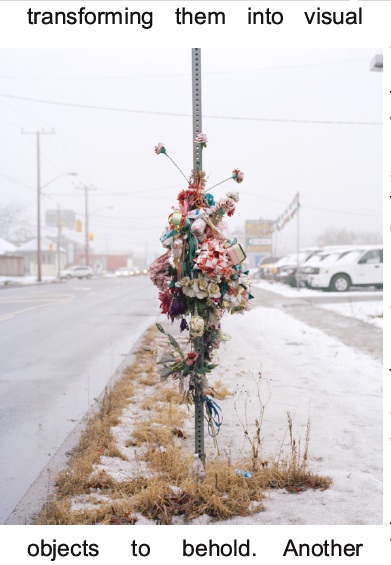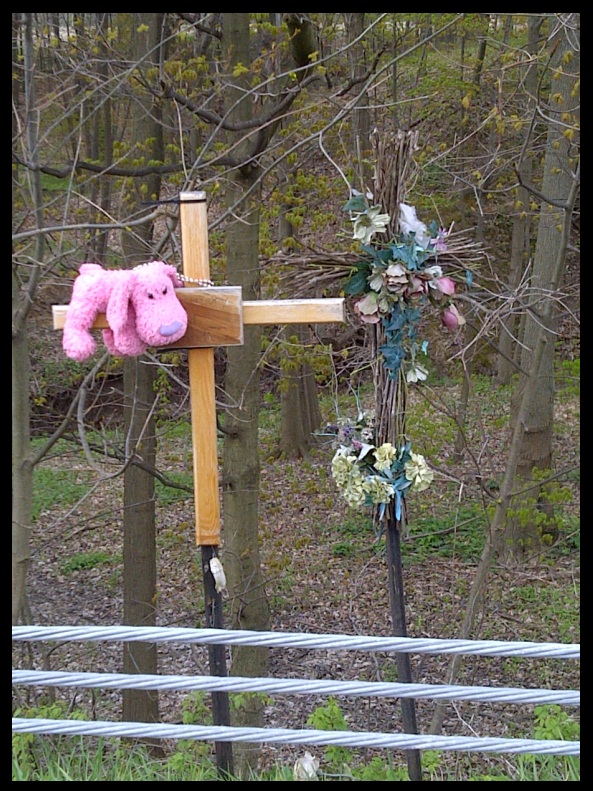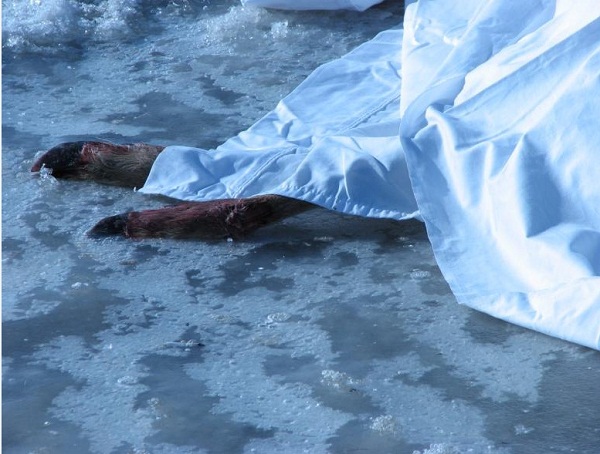
Indeed, the prevalence of roadside memorials has increased significantly over the past several decades and there is little doubt that each of us has encountered them at some point. Roadside memorials are essentially visual manifestations of profound suffering and loss. They mark the site where a motor vehicle accident has occurred and the death that resulted from it (however , many memorials, especially in major cities, have little to do with motor vehicle accidents and more to do with cycling accidents, innocent bystanders or anything else that faithfully marks the site of passing).
In areas where large gravestones or plaques cannot be placed, for a variety of reasons, makeshift memorials take their place. These sites grow with each flower, ribbon or object and deplete with the wind, rain or snow; they are in a continuous state of flux. The organic quality of roadside memorials may directly reference the very epehemerality of life itself. Moreover, in their various forms and inclinations, they challenge Western society’s visual seperation of the living from the dead; therefore, as they subsist, roadside memorials carry the spectre of mortality into the public sphere, a space where even speaking of death remains taboo.
Post-mortem/momento mori photography during the Victorian age is a fascinating though dark and unsettling movement.

Encountering the idea of death may be one of the reasons why people take issue with the appearance of roadside memorials. For them, they represent a veritable “distraction” while driving, are considered “unsightly” or a “vandalism of public property”. For the families of the deceased, roadside memorials allow the opportunity to mourn their loved one(s) at the very place of their passing. The level of emotion generated by being near the actual site where a loved one has died is different from standing beside their final resting place in segregated communities of loss that are the modern cemetery.
Not only are roadside memorials, as markers of loss, important to the families and groups that maintained a relationship to the deceased, but they powerfully address the living by acting as memento mori (reminders of death). It is through them that one may better appreciate the present.
Toronto-based photographer Erin Riley’s series of photographs depicting roadside memorials in and around the Greater Toronto Area (GTA) specifically engages the publicization of loss and its visual manifestation. Riley’s images are strikingly beautiful and skillfully composed, yet they raise ethical questions precisely because they aestheticize markers of death sites by transforming them into visual objects to behold. This theme was explored in Jarrod Barker’s April 2010’s Umwelt at the Norfolk Arts Center with a central piece depicting a virtual gallery memorial in conjunction with projected audio/video loop of a recently deceased Deer- struck down by a motorist, the piece becoming essentially a rural memento mori.

Another question concerns the identification of deceased individuals and whether or not their names should be made public through the vehicle of art. That being said, Riley’s photographs do provide an eloquent record of roadside memorials within the GTA and speak to their social and cultural value. Ask yourself: where do you stand on this issue?
It would seem that, for the families of the deceased, roadside memorials serve the purpose of exactly that: the memorializatin of a life. [ “even” an animal life CP ] They also serve a function for the living, reminding us that life is fleeting and that the dangers of the road are real. Ultimately, rather than causing drivers to collide, roadside memorials may force drivers to more aware of the consequences of speed, negligence and drunk driving. May roadside memorials continue to stand where lives have fallen. For the Silo, Matthew Ryan Smith.
Supplemental– http://www.rideofsilence.org/memoriam.php
I like your articles. Keep up the good work
Saved as a favorite, I love your site!
Also visit my blog – about
Great article. I’m going through many of these issues as well..
Aaawww shucks! Thanks for saying
bookmarked!!, I like your site!
Thank you for the kind feedback You can also visit us at The Silo on Facebook
You can also visit us at The Silo on Facebook
Hi there! Someone in my Myspace group shared this site with us so I
came to check it out. I’m definitely loving the information.
I’m book-marking and will be tweeting this to my
followers! Terrific blog and excellent design.
Sad but pretty…
Pretty! This was an extremely wonderful post. Many thanks for
providing this information.
Awwww. Thanks for the kind words PS don’t forget to click on some of the ads
PS don’t forget to click on some of the ads 
Its like you read my mind! You appear to know so much about this,
like you wrote the book in it or something.
I think that you can do with a few pics to drive the message home a
bit, but instead of that, this is great blog. An excellent read.
I’ll certainly be back.
Good day I am so happy I found your site, I really found
you by mistake, while I was researching on Aol for something else, Regardless I am here now
and would just like to say thank you for a tremendous post and
a all round entertaining blog (I also love the theme/design),
I don’t have time to read it all at the moment but I have book-marked it and
also added your RSS feeds, so when I have time I will be back to read a lot more, Please do keep up the superb jo.
Available in Dallas Texas https://dallasneighborhoods.org/
Very current and informative. Did not know how times had changed soo much.